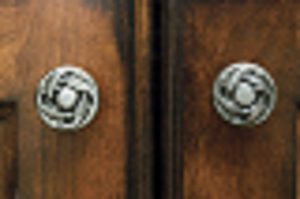
Everything you need to know about knobs and pulls.
Knobs and pulls are subtle additions that offer a simple way to update the look of any space. From the variety of styles to the myriad of colors and finishes, adding a knob or pull to any cabinet or piece of furniture will create a fresh impact on your existing space. Knobs and pulls can serve their purpose as nice accessories for your cabinets. But with all the options to choose from, how can you make the best decision for your purposes?
Knobs vs. Pulls
Although knobs and pulls can be distinguished by their shape and number of fasteners, all these options serve the same function, to help open a cabinet door. Typically, then, the choice between the two comes down to pure preference. Some people prefer pulls because they provide a sleeker, modern aesthetic. Others may prefer knobs for their classic and vintage look. However, it all still depends on the exact knob or pull, since they all come in a variety of styles.
Types Of Knobs
There are two main knob types: solid and hollow. Solid knobs are often sturdy pieces made of metal that tend to feel hefty. Requiring more materials, these types of knobs tend to have a high-cost associated with them.
Hollow knobs are often lighter and well, hollow inside. The quality of hollow knobs is not hindered by the hollowness, in fact, hollow knobs can come in a variety of textures and prints, which can please a variety of styles. Knobs also can come in a variety of shapes as well, including round, oval, or even feature a unique sculptural design.
Types Of Pulls
There are a variety of styles that pulls come in, the most common ones include: handle pulls, bar pulls, bail pulls, cup pulls, and finger pulls.
Handle pulls are one of the most basic, featuring a simple handle that is attached to a cabinet at both ends. These types of pulls are often featured on drawers horizontally, but can sometimes be seen vertically on cabinets.
Bar pulls are similar in design to handle pulls, but differ slightly in appearance. Bar pulls do not connect to the cabinet or drawer on either side, instead they are simply suspended by visible supports in the middle. These pulls offer a sleek shape, and are often used in very modern designs.
Bail pulls, also referred to as drop pulls, made up of two anchoring points with a moving handle in between. Typically these types of pulls are used exclusively on drawers since their purpose would not be served well on a cabinet door.
Cup pulls are distinguished from the rest by their upside-down cup shape. These pulls offer a smooth, sleek appearance, and somewhat of a rustic, country feel. Just like the bail pulls, these are typically seen only on drawers and rarely used on cabinets.
Finger pulls are the unique pulls compared to all the others, they are distinctive in that they are installed on the backside of a cabinet door. They are made to be opened by just a couple of fingers, offering a very sleek and minimalistic appearance.
There are a variety of pulls and knobs available and it can be daunting undertaking choosing which one to pick.
Choosing Your Pulls And Knobs With WalterWorks Hardware
Want more information on choosing a pull or knob for your drawers? Check out our weekly blogs or stop by our Annapolis showroom. From homeowners to trade professionals, WalterWorks Hardware has built a name for itself throughout Maryland, Washington, D.C., and northern Virginia including Annapolis, Columbia, Baltimore, and Easton. With a large showroom in Annapolis, Maryland, WalterWorks Hardware is always ready to help you or your clients find the perfect hardware for their home. WalterWorks Hardware offers a wide selection from the most respected manufacturers in the industry. For more information, please call 410-263-9711 or contact us to talk to a hardware expert at WalterWorks Hardware.
